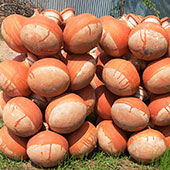Design Resource
Traditional Pottery Making - Agartala, Tripura
Ritual Pots
by
The third-smallest state in the country, Tripura, is located in Northeast India. To its north, south, and west, it is bordered by Bangladesh and the Indian states of Assam and Mizoram to the east. Agartala, the capital of Tripura, is also the second-largest city in northeast India after Guwahati, both in municipal area and population. It is one of the fastest developing cities in India. The handicrafts of Tripura are unique and attractive. The artisan could produce extraordinary crafts from simple materials like clay, bamboo, and wood. Hinduism, Buddhism, and Islam are the three distinct cultures that have united together to give shape to a unique tradition found through age-old work of crafts made out of very simple materials like bamboo, clay, wood, palm leaf, etc.
One of the oldest handicrafts of India is Pottery. In the early days, clay pots, bowls, and large shells were hand-built using a simple coiling technique. Potter’s wheel was invented later. People master here some of the traditional products like pots on manual potter wheels. Pottery is made by forming a ceramic body into objects of a required shape and heating them to high temperatures in a kiln, which increases their strength and setting their shape.
Pottery can be decorated before or after firing. A lump of clay must be prepared before starting some shaping process. One needs to ensure even moisture content throughout the body while kneading. Air trapped within the kneaded dough needs to be removed. The process of de-airing can be done either manually by wedging or by a machine called a vacuum pug. Wedging can also help produce an even moisture content. The clay can be given any shape by using different methods after it has been de-aired and kneaded. Once the final shape is given, it is dried and then fired in a kiln.





